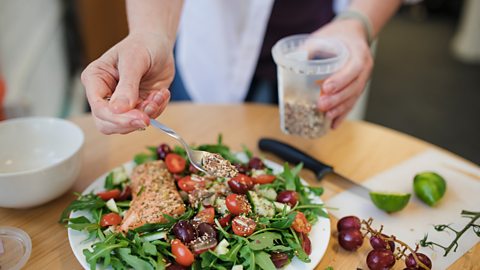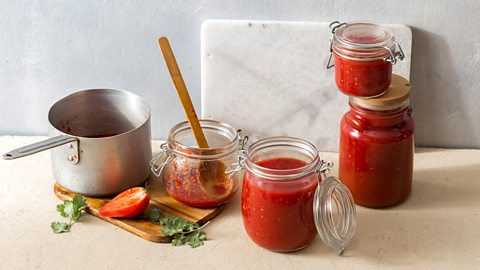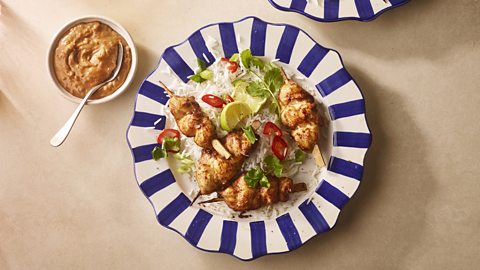The quickest way to oven roast a chicken
Using this fail-safe method for roasting a chicken could cut cooking time by up to 30 minutes…
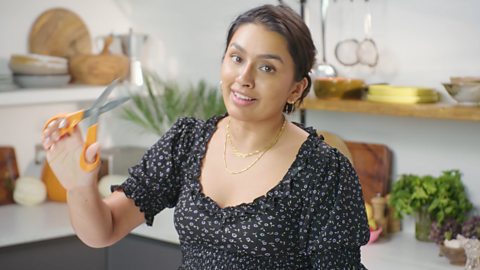
Is there anything more glorious and comforting to be wafting through your kitchen than the smell of a chicken roasting? I absolutely love it. For lots of people, it’s the smell of home, of family sitting around the table sharing stories and fighting over crispy skin.
In fact, roasted chicken is loved, in some shape or form, all over the world. Musakhan is a Palestinian dish where chicken is marinated in spices and roasted in the oven with jammy sumac onions. Then there’s Nigerian peppered chicken, where the roasted (or fried) meat is stewed in a thick tomato and scotch bonnet stew.
There are lots of different schools of thought when it comes to making the perfect roast chicken, and most families have their preferred method. But there’s one technique I swear by for great results every time – and it just so happens to be super quick, saving time and energy.
Choosing your chicken
If you can, buy your chicken from a butcher – it means you can ask questions about its age and where it comes from. This is helpful because, while some older free-range birds have great flavour, the meat can be a bit tougher and may require a lower, slower cook.
Free-range and organic chickens have more space to exercise and develop muscle naturally. This makes them more expensive but, as well as a deeper flavour, they have juices that are like nectar, which make the most incredible gravy. And if you factor in leftovers, as well as boiling up the carcass for soup or stock, they can be pretty good value for money.
My motto when it comes to buying a chicken is always to go big if you can. You’ll never regret having leftover chicken in your fridge – it can be used in a multitude of ways. My go-to dishes for leftover chicken are spicy garlic and chicken noodle soup and a quick chicken pho. Both of them are amazingly good.
Why spatchcock?
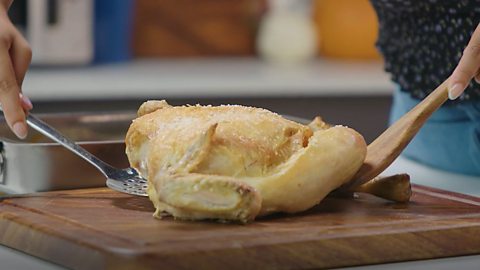
Spatchcocking sounds a little scary, but it’s very easy to do. By cutting the backbone out with a stout pair of kitchen scissors, you can flatten the bird so that the legs and breast are all on the same level. This cuts cooking time by 15-30 minutes, making roast chicken a far more practical option for midweek.
This technique also helps solve the problem of the breast meat becoming dry and overdone by the time the leg meat is ready. Leg meat takes longer to cook and contains lots of collagen which, when heated at a high temperature for long enough, will convert into gelatin and give the meat a lovely juiciness. Breast meat, on the other hand, is very lean; the muscle fibres shrink as they are heated, forcing the juices out. This leaves the meat dry if it's in the oven too long.
By flattening out the chicken, you’re exposing the legs to the heat of the convection currents in your oven. And, as food on the edges of the pan cook quicker than what's in the centre (think about how chips on the outside of the oven tray always crisp up first), the legs will get the higher heat they need while the breast cooks a little more slowly.
Another bonus is that there’s more surface area exposed, so you get more of that lovely, golden crispy skin – the best bit in my opinion!
Quick roast chicken
By spatchcocking a medium-sized chicken it could be cooked in just 45 minutes
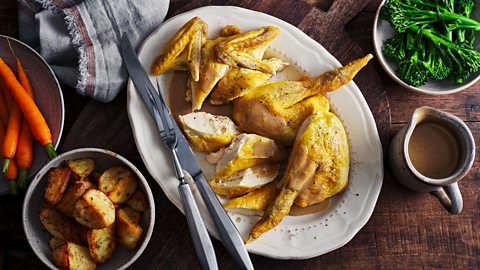
Preparing your chicken
I recommend salting the skin for a couple of hours before you plan to cook your chicken and leaving it uncovered at the base of the fridge (never store raw meat on the higher shelves as you risk it dripping onto other food and contaminating it). The salt will draw moisture out of the skin through osmosis which helps to get that lovely crispy skin.
When roasting a chicken whole, it's common to pop some aromatics – like lemon, herbs, onion or garlic – into the cavity to infuse the meat with extra flavour (you can also pour a bit of wine in there to help with moisture). I like to do a similar thing with spatchcocked chicken, putting a halved garlic bulb and thickly sliced onions in the base of the pan with a drizzle of olive oil, and sitting the chicken on top. Remember, though, you don’t want too much veg under the bird as you need it to have contact with the pan to get all the caramelised deliciousness at the bottom.
As for the stuffing, I always cook this separately regardless of how I'm roasting the chicken. If you pack it inside the bird it can play havoc with cooking times as it stops heat circulating evenly. You may also find that by the time the stuffing is cooked the meat is dried out.
When you're ready to roast, make sure you pick the right oven dish. It needs to be just big enough to fit the chicken in (too big and the juices will burn and evaporate, too small and the chicken will almost poach in its own juices) and the heavier it is, the better. It should be compatible with your hob too, which is essential for making the gravy later.
Is basting necessary?
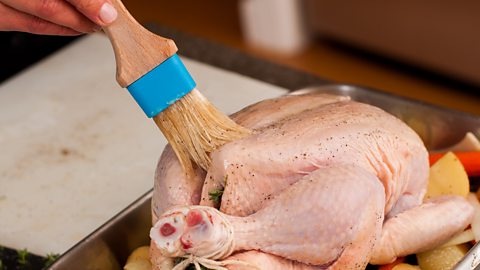
There are lots of different opinions on basting. One school of thought is that we should baste the chicken every 15 minutes to keep the meat tender, but in actual fact, the chicken can’t reabsorb the juices so it won’t make any difference to the texture or flavour of the meat.
Can it help get the skin crispy, though? Some recipes say that once the chicken has rendered out some of its fat, that’s when you should baste it, as the fats and protein in the dripping will help get the Maillard reaction going which encourages browning. (Geeky bit: the Maillard reaction is the chemical reaction between amino acids and reducing sugars. It's what produces those deep, complex flavours of browned or roasted food.)
Others think that leaving the chicken completely undisturbed is best as any kind of movement will create steam, which will de-crisp the skin.
My opinion is that although basting might improve the appearance of the bird with an even brown colour, opening the oven door reduces the temperature so slows down the cook. And as it won’t impact the tenderness of the meat anyway, I don’t baste. Plus, it’s more work and I’m all about the easy life!
Your roasting time will depend on the size of the chicken but to check it’s cooked properly, ideally test with a temperature probe inserted into the thickest part of the thigh; it should reach 75C. You can also stick a skewer or sharp knife into the thigh to see if the juices run clear, but this is less definitive.
Crispy skin
If you have salted your chicken and left it uncovered in the fridge, that’s a great start for drawing the moisture out of the skin. The drier the skin is when it goes in the oven, the crispier and more caramelised it will be when it comes out. Some people like to crank up the heat for the final 10 minutes of the roast to crisp up the skin, but I find (especially with a spatchcock chicken) that roasting fast and hot all the way through gets the best results.
If you want to get really cheffy, you can put salted chicken skin (if you’ve taken it off some thighs, for instance) between greaseproof paper and two baking trays, and bake for 25 minutes at 200C. The result will give you a proper crispy umami hit!
Resting
It’s really important to let your chicken rest for at least 15-20 minutes after it's finished cooking. I know at this stage the urge to dive into that beautifully cooked meat is irresistible – but you must be strong! During cooking all the muscle fibers firm up and push out their moisture, which means if you carve straight away, all those juices will pool out. If you let your chicken rest, those fibers will relax and reabsorb their moisture – that juicy meat is worth the wait.
You can create a tent with foil to keep it warm, and the skin crispy. Some people prefer to leave the chicken uncovered for fear of the skin going soggy – this is OK too if you have a warm kitchen and nice hot gravy to pour over.
It’s all gravy
There are endless ways to make gravy, including from granules, but you must (I mean this) use the dripping and those gorgeous little flavour bombs at the base of the roasting tin. Put the roasting pan on the hob and use some water or wine to deglaze the pan, scraping up all those little bits of stuck on caramelized juices. Add it to your preferred gravy method and it will taste better, I promise.
Roast chicken is a classic winter warmer, but don’t relegate it to a cold-weather only dish. With this spatchcocking method, you can do a roast chicken as a midweek meal, and serve it with a colourful salad on a summer evening. The spatchcock method works beautifully on the barbecue too. You could also jazz up your side dishes with different flavour combinations like ‘nduja butter roast potatoes and honey cumin carrots. Enjoy experimenting!
Originally published January 2022
